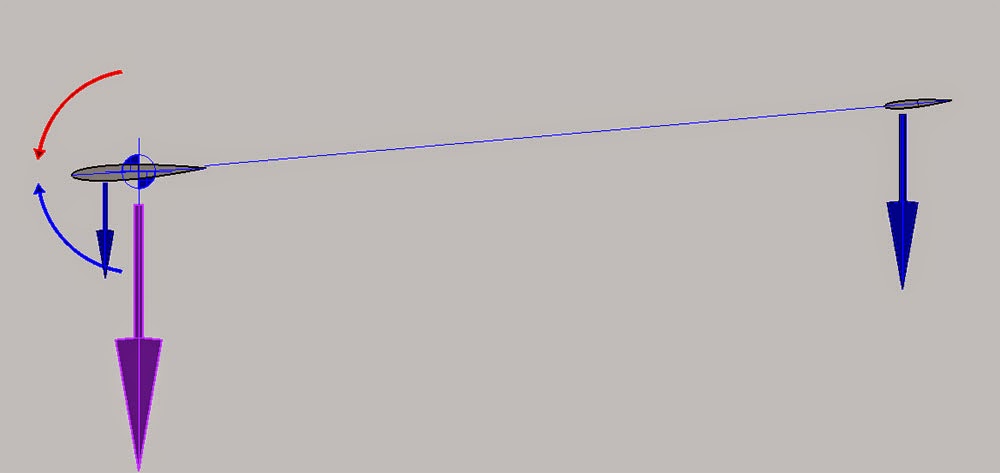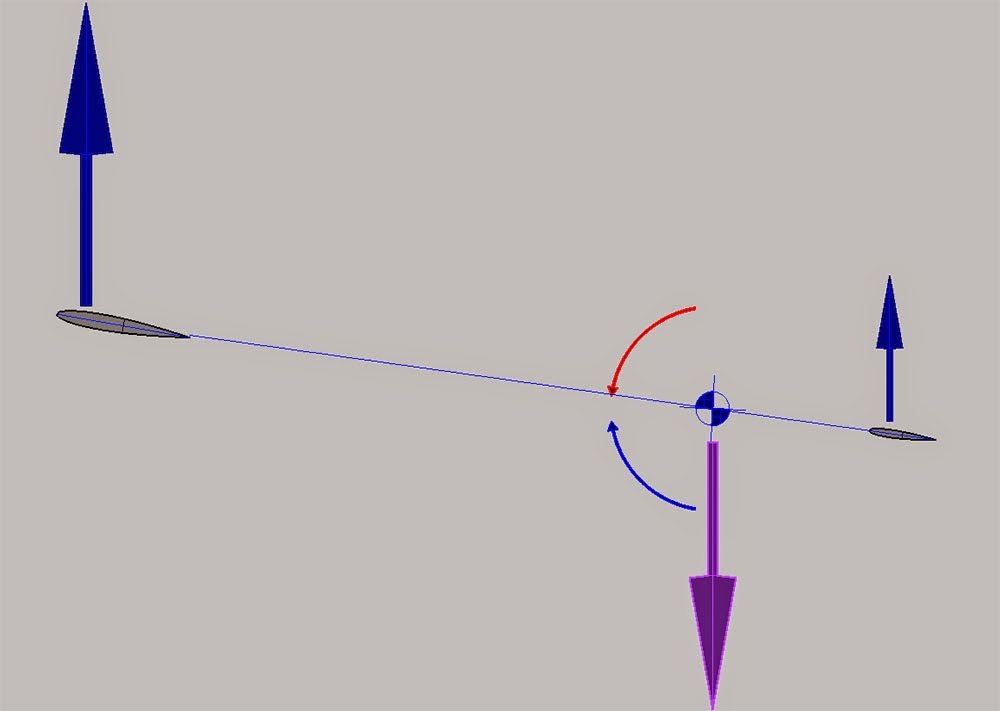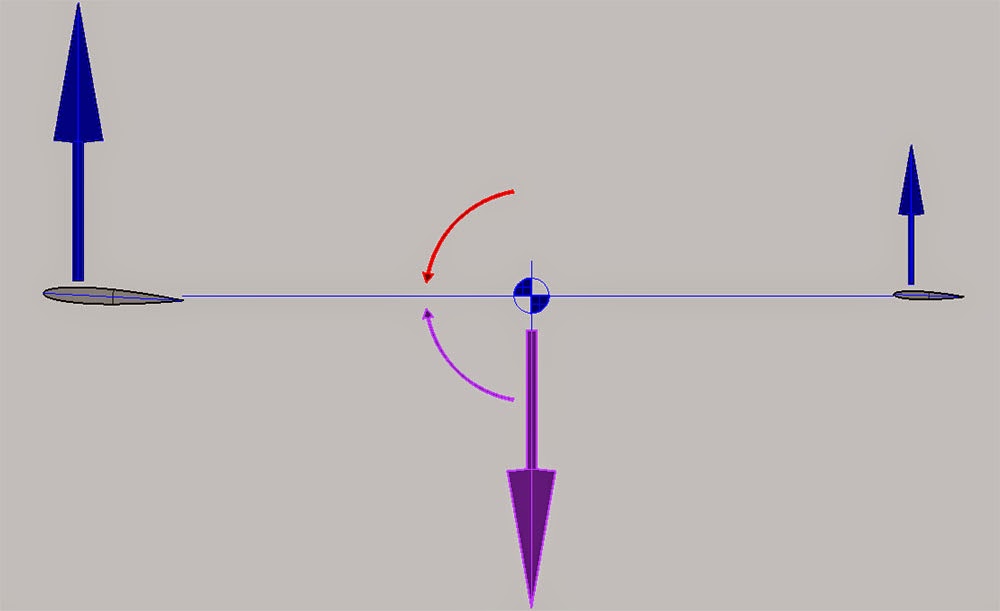Time to answer some questions about stability in pitch.
Over the past few months of testing we have found some very interesting things worth sharing.
Stability as an Alternative to Active Management
Without going into the maths, stability in pitch has a strict definition in aircraft theory and is a requirement for what I would consider ‘sustained foiling’.
Meaning the ability of a boat to remain ‘balanced’ on foils without continuous corrections in the form of course changes, weight shifts, and adjustments to power settings (sheet tension).
It is possible for a boat to sail with the hulls clear of the water in spurts without being stable in pitch and/or heave. Even sustained ‘bursts’ of a few hundred metres are feasible.
This is what is happening in the majority of As with C and J foils, as well as in the NACRA 17.
When you compare these sporadic foilborne tracts (that are becoming more prolonged as sailors master new techniques) with the ‘rock steady’ sustained foiling of a Moth or AC72, the difference is obvious.
Stability at a Price
The interesting thing is that stability necessarily involves a drag penalty.
Some stable setups also have additional drawbacks, such as the need to ‘tack’ the foils (retract the windward one as is necessary with the ‘acute L’ concept pioneered by ETNZ).
In the A Class, the drawbacks of stable foiling make the choice rather marginal:
– Sail area and power are limited
– The hulls have an extremely low displacement to length ratio
– Simplicity is paramount as there is only one pair of hands on board
– Maneuverability is a priority because racing takes place on relatively short windward/leeward courses.
On larger boats stability is vital for control.
On a small boat such as an an A, the centre of gravity (CG), heading and sheet tension can all be altered very quickly in a coordinated way by the skipper: A step back, a pull on the tiller, letting out an armful of sheet… It can all happen in less than a second in response to a feeling in the inner ear.
People learn to ride unicycles, so mastering a small unstable vehicle is not outside the realm of possibility.
When the top skippers in the A Class today speak of learning to foil, they are referring to mastering the technique of prolonging their stints of balancing on an inherently unstable platform.
The evidence on the racetrack shows that this solution, when mastered, can be competitive since bursts of unstable foiling can offer gains compared to more conservative foil-assisted sailing.
The risks involved are higher because a mistake is more likely to end in capsize, but taking risks to win a race is nothing new.
Experimentation
As our followers know, we believe in sharing what we learn, explaining the reasoning behind our development choices and, always, following an objective evidence-based process.
If theory disagrees with measured findings, then the theory must be revised.
In our early development of Paradox, we found that the original stable configuration brought unacceptable penalties in terms of drag and maneuverability.
Stable full foiling was slower around the course than unstable ‘jumping’.
In response we tested a few alternative configurations and came up with the current setup that is ‘just on the stable side of neutral’, but has much lower drag.
We accepted a higher takeoff speed and more moderate ride height in exchange for simplicity, maneuverability and, above all, reduced drag.
We started out 2013 with a deficit of boatspeed and ended the year with some outstanding upwind pace and a small edge downwind that we are confident we will be able to build on.
Much will be learned at the Worlds and we will continue development after that.
The fascinating question in the A class at the moment is about striking the optimum balance between stability and drag.
Mental Model
The illustrations below aim to explain the key factors affecting pitch-stability.
The simple way to think about it is this: A stable system will return to the initial state after being upset by an outside force.
When you consider a system made up of a main lifting foil, a rear foil, and a CG, it is easy to see that the relationship between these three objects will determine system behavior.
Think of the two foils as supports at either end of a plank. Then the CG is a person standing on that plank.
If the person stands right at one end of the plank, then the support at that end will be taking all his weight and the support at the far end will be taking almost no weight.
If the person stands exactly half way along the plank, then both supports will be sharing the weight equally.
Now imagine that the supports are not solid and immovable.
Instead they are peculiar springs that can only push back so hard before giving out.
The main foil has a higher threshold (maximum absolute lift) than the rear foil.
The forward foil could take all the weight unassisted, but the rear one can only help up to something like, say, 35%.
If the CG moves too close, the rear foil will at first attempt to push back harder.
But eventually it will be unable to keep increasing its lift and will subside.
Here some dynamic factors come into play: As it subsides, the ‘apparent’ Angle of Attack (AoA) changes. But we will ignore dynamic effects for now.
Key to understanding this system is the concept that as the AoA of each foil increases, so does the lift contributed by that foil.
When the whole system pitches up, lift will increase for both foils.
The rate of change for each foil depends on initial loading (lift coefficient), section shape, aspect ratio and initial AoA.
The lift generated by a foil will change a different amount when going from, say, 1 degree to 3 degrees, compared to when going from 4 degrees to 6. In both cases the change was 2 degrees, but, since the changes happened at different points on the graph of Lift Coefficient vs. AoA, the change in total lift force was not the same.
Now you can see that, all other things being equal, the relative angle of the main foil and rudder foil is very important to foiling behavior.
The relative angle influences the differential in the rate of change of lift.
In other words the initial setting will affect the difference in rate of change of lift as the whole system pitches.
When the CG is forward, the rear foil has a long lever arm and is therefore most effective at restoring neutral trim. It will naturally tend to restore level trim.
As the CG moves back, the rudder foil must share more of the weight so it cannot be set to neutral.
Instead it will be sharing vertical load.
This reduces drag but makes the choice of rudder foil section and area crucial: Its rate of change of lift must be greater than that of the main foil if it is to maintain stability (Note that to make the rudder share vertical load, its AoA has to be increased relative to that of the main foil. If the rudder is left ‘neutral’ and the whole boat is pitched up, then the increase in lift for the main foil will tend to up ride height and the rudder will still want to restore level trim).
The final complicating factor is the bow-down trimming moment exerted by the rig.
This has to be taken into account when designing and setting up, but conceptually it does not alter the basic understanding of the system: adding a moment is equivalent to moving the CG so that it puts more pressure on the support that would be forced down by that moment.
 |
| When this same system pitches down, main foil lift drops to zero and then becomes ‘negative’ (pulling down). All along rudder foil force is increasing, exerting leverage to restore level trim. |









